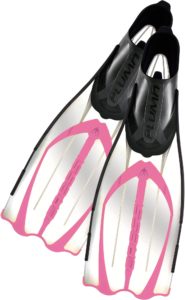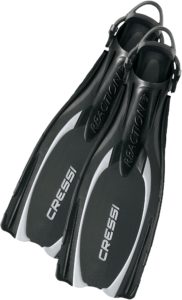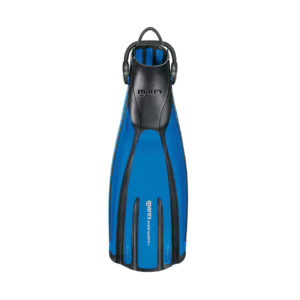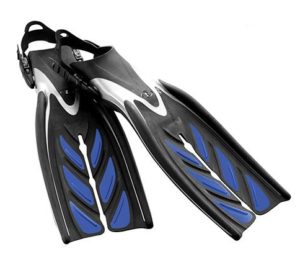The wrong dive fins can leave us either uncomfortable or ill-prepared for our dives. And while it may seem like a simple choice, finding the right dive fins can be a challenge. Fin styles and fin technology — as with all dive gear — are always changing. Full-foot, open-heel, bladed, split and hinge fins have evolved over the years. Additionally, both types of foot pockets and blades are available in lots of styles. With that in mind, here’s our guide to choosing the right dive fins for you.
Stage one: fin styles
At the first stage of selection, fins are essentially available in two styles: full-foot and open-heel.
-
Full-foot fins
Full-foot fins, sometimes called “snorkeling fins,” have a foot pocket that slips on like a shoe. These fins are sized like shoes and you’ll generally wear them with bare feet.
Pros: These fins are popular for diving and snorkeling in warm water, especially from boats. Full-foot fins are generally lighter, making them ideal for travel. And, you won’t need to pack any boots in your luggage with these fins. You can also put them on quickly if something interesting is circling around the boat and you want to snorkel at the surface. Full-foot fins have improved markedly over the years, with modern full-foot fins often mimicking the more powerful, bladed design of their open-heel relatives.
Cons: Full-foot fins often have smaller blades in comparison to their open-heel counterparts. This means you’ll have less power to make progress against currents, swim quickly, or deal with emergency situations. Trading your wetsuit boots for the full-foot option means that — unless you’re in warm, tropical waters — your feet may also get cold since they’ll have no thermal protection.
Also, a week’s diving with full-foot fins tends to cause abrasions to a diver’s feet. Fin socks can ease the problem, but even so, divers often develop blisters on their heels over 15 to 20 dives on a liveaboard vessel. Carrying your scuba unit on your back, barefoot over hot sand or rocky surfaces, makes full-foot fins usually unsuitable for shore dives.
Tips: A proper fit is key with a full-foot fin. Make sure that the foot pocket doesn’t pinch your feet. Once you’ve got the fin on, tilt your foot forward so you’re effectively in a ‘tip-toes’ position. This ensures that the fin will stay firmly on your foot, even when you’re finning hard.
Example: Try the Cressi Pluma fins, which benefit from the same design features as more powerful open-heel fins.
-
Open-heel/adjustable fins
Divers wear open-heel fins with wetsuit or drysuit boots. The foot pocket has a strap or bungee cord that rests over the back of the ankle close to the Achilles tendon. You can tighten or loosen open-heel fins, depending on the strap type, to suit your preference and boot style.
Pros: There is a much broader choice of open-heel fins for scuba diving. The bladed area of the fin is generally larger, offering more power when finning. Open-heel fins are also more adaptable and easier to fit. A size “medium” fin may fit someone with size 6 to 10 (UK/US) feet in wetsuit boots due to their adjustable straps. Wearing a boot also means that your feet have some thermal protection and the agitation that may cause blisters diminishes. You can also carry open-heel fins to an entry point while wearing booties, so shore entries are generally no problem.
Cons: Open-heel fins usually weigh more than full-foot fins, and you’ll need to wear dive boots. These fins also tend to be bulkier, so will eat into more of your baggage allowance on flights. Having to wear boots and fins makes them slower to put on as well, so you’ll be a little less flexible about jumping into the water on short notice. And finally, the larger blades offer more power but, conversely, can leave infrequent divers more prone to cramping.
Tips: Although most open-heel fins come in common S-M-L-XL sizes, proper fit is key. Make sure your fins are suitable by trying them on in the dive center with the boots you intend to wear. Also, if you want to wear the fins with both wet- and drysuit boots, make sure the foot pocket large enough to fit both. Consider spring clips for open-heel/adjustable fins if the fins you choose don’t come with them. These will make getting the fins on and off far easier.
Example: Try the Cressi Reaction EBS fins, which feature a flexible blade and easy, yet powerful, kicking capabilities.
Stage two: blade types and accessories
Blade style and construction are key to making the correct selection. You can choose from bladed fins, jet fins, split fins or hinged fins.
-
Bladed/paddle fins
The classic bladed design has evolved over the years, representing the best choice for most divers. Now with channels, ribs, vents and rails to help channel water and offer propulsion, bladed fins are great all-around. The best bladed fins offer excellent propulsion and, when you use them correctly, their stopping, turning and reversing capabilities almost equal a jet fin. They allow you to flutter or frog kick as you wish. In addition, some bladed fins offer different sizes and stiffness to suit those with stronger or weaker legs. Drawbacks are that the blades are often quite large and long — great for propulsion but it can be difficult to fit them into your baggage.
Suitable for: Most divers are comfortable in a traditional bladed/paddle fin. Don’t pick a blade that’s too large if you’re prone to cramping.
Example: The Mares Avanti Quattro Plus fins have been around for a while, but they’re a classic for a reason.
-
Jet fins
Beuchat originally marketed the pioneering jet fins in the 1960s, and they maintain enduring appeal for many divers. When Scubapro bought the rights to the iconic design in the 1970s, the fins went mainstream. Hefty and solidly constructed, jet fins suit those who want great propulsion. Technical and drysuit divers often favor these squat fins, using their weight as a ballast. Their spring-strap design makes them easier to get on and off, and they’re ideal for close-quarters positioning and turning. These fins are usually not suitable for wetsuit/tropical diving because they’re so heavy, and their weight can negatively impact the positioning and trim of inexperienced divers, who tend to drag their feet while wearing them. Jet fins can also cause leg cramps for those who are unused to them.
Suitable for: Experienced divers in tougher conditions, but arguably not the best choice for those who wish to travel or wear them in conjunction with board shorts and a rash vest in tropical conditions.
Example: Scubapro Jet Fins are the classics here.
-
Split fins and hinge fins
We’re all after more efficiency. Both relatively new design ideas, split fins and hinged fins offer good propulsion when flutter kicking. A vortex created between the split of the blades funnels the water and creates propulsion. Split fins may not offer the ultimate power of a jet fin or bladed fins, but they are a nice way to propel yourself around a reef with less stress on your legs and back. The downside of split fins is that they generally make turns and reverse finning much more difficult.
Hinged fins, by contrast, have evolved with a blade pivoting around the center of the fins. This creates a springing propulsion effect, driving the diver through the water and using the fin’s flexibility to his advantage. Sometimes a good compromise between a bladed fin and a split fin, the hinged fin offers solid propulsion with less weight and strain on the legs and back.
Suitable for: Divers who have weaker legs and dive more commonly in tropical or less-demanding conditions. Hinged or split fins also work well for those who have not yet perfected their finning or do not need to stop, turn and reverse easily.
Example: Tusa X-Pert Z-3 Zoom fins are a good choice for a split fin.
The right dive fins should be unobtrusive and allow you to dive comfortably. Choose poorly and you may find your fins incompatible with your finning style, travel arrangements or diving conditions. Choose wisely (or choose a few different styles to suit your different needs) and your fins will have a lasting impact on your diving for years to come.
The post Finding the Right Dive Fins for You appeared first on Scuba Diver Life.
from Scuba Diver Life https://ift.tt/2mvc7Hc





No comments:
Post a Comment